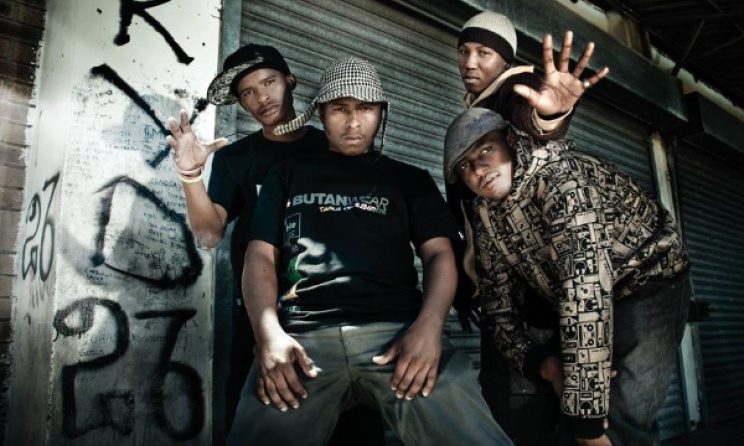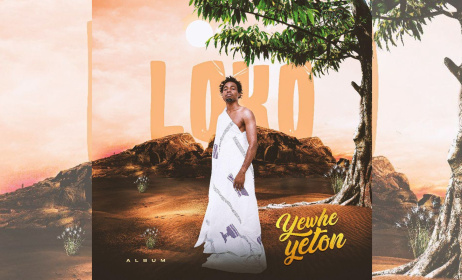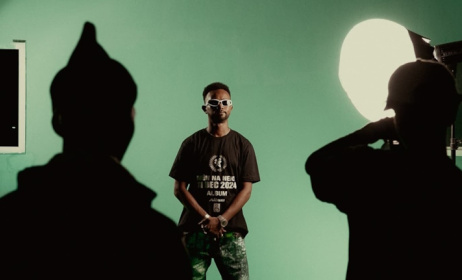Hip-hop in South Africa
South Africa's history is steeped in the politics of apartheid, struggle and survival. For decades it was common for public gatherings to be dispersed violently, as witnessed by the Sharpeville massacre of 1969, the student uprising of 1976 and numerous other public protests. When speaking about hip-hop in South Africa, it is important to consider this back-story of suffering and overcoming adversity, as it was against this backdrop of apartheid that hip-hop gained its foothold in South Africa.
 Driemanskap.
Driemanskap.
The roots of South African hip-hop (80s-90s)
Perhaps the most definitive act in South African hip-hop and the group largely credited as forerunners of the movement were Prophets Of The City (POC), formed in Cape Town in the late 1980s. Founding member DJ Ready D recalled those early years in the documentary FedeFokol: 25 Years of South African Hip Hop: “I was your typical Cape Flats kid, running around and doing what Cape Flats boys do. I didn’t really think I would assume the role of an activist within our communities or through music.”
POC released their first album, Our World, in 1990. Today they are credited as the first hip-hop crew in South Africa to record and release an album. Led by the inimitable voice of Shaheen Ariefdeen on raps, POC would carry on carving a niche for themselves on the South African hip-hop landscape, performing overseas in the 90s as well as at Nelson Mandela’s inauguration in 1994.
Around the same time, another hip-hop crew with a similar vision arose from the Cape Flats. Led by the dynamic rap talents of Emile XY, Black Noise would go on to carve their own path in South African hip-hop, despite changing their lineup as time went on. Formed in 1988, the group soon found a loyal following in Cape Town and Joburg. In 1992 they signed to the label Tusk (the local subsidiary of Warner Elektra Atlantic) and released their debut album Pumpin’ Loose Da Juice!. Emile has been the mainstay of the group, going on to champion events such as the annual African Hip Hop Indaba, which showcases the different elements of hip-hop (breakdancing, graffiti, MCing, DJing) over three days.
Importantly, political consciousness was always at the centre of their vision. Adam Haupt, Associate Professor of Media Studies at the University of Cape Town, sums up this early period of South African hip-hop in his book, Stealing Empire: “Like POC, Black Noise has always aligned itself with black consciousness thinking, hence the crew's consistent reference to black – as opposed to coloured – identity. This, in part, is what the term 'conscious' hip-hop indicates, but it also alludes to the idea of raising critical consciousness via hip-hop as a lifestyle, philosophy or art form. It is in this area that POC and Black Noise have been active.”
Popular discourse around South African hip-hop typically centres on the overarching influence of POC and Black Noise. While these crews – cultural movements in their own right – deserve their place in history, it is important to not overlook other regions in South Africa which served an equally important role in raising awareness about hip-hop culture, such as Def Boyz in the Eastern Cape, whose grassroots initiatives continue to reverberate through small communities and inspire a new legion of rappers. One of the founders, Xolile Madinda, is involved in literacy projects and community debates to uplift his community.
In Johannesburg, hip-hop took centre stage at Le Club, a mecca of sorts (similar to The Base and Club Fame in Cape Town) where the current cream of South African hip-hop cut its teeth. Founded by DJs Bionic and Blaze, Le Club's centrality to the scene cannot be over-emphasised. Vouks, a legendary breakdancer who is still active on the scene, had this to say about the significance of the club, which has since been converted into a clothing store: “I would call it the hip-hop hub for all youngsters, your top MCs and your underground MCs. This is where the cyphers and the B-boys and everything went down every single weekend.”
Other musicians experimented with hip-hop during the 1980s and early 90s, long before it entered the mainstream. As early as 1984, the late bassist Sipho Gumede was dabbling in hip-hop as The Boogie Man, rapping in isiZulu on tracks such as ‘Jika Jika’. Senyaka had a hit in the late 80s with ‘Go Away’, a song that bridges the gap between 80s bubblegum/disco, hip-hop and the kwaito genre that would dominate the local music industry in the 1990s. Rapper Taps released albums such as Let’s Go (1990) and Young Hip And African (1991). Natano Braché rose to prominence in Cape Town as a club and radio DJ going by the name DJ Natdog. His maxi-single ‘B-boys’ was released in 1990. I.N.T.R.I.B.E, a group from Johannesburg, released Bubblegum In My Afro in 1992. Their name stood for Intelligent Natives Teaching Revolutionary Intellectual Black Education, a nod to movements like Public Enemy and the Jungle Brothers, as well as POC and Black Noise, whose music carried a message of self-awareness.
An important factor in the rise of hip-hop in South Africa is the emergence of YFM, the Gauteng-based regional radio station which launched towards the end of 1997. The Sprite Rap Activity Jam, an hour-long weekly segment co-hosted by Kalawa Jazmee co-founder DJ Oskido and Rudeboy Paul, heralded another phase for the evolution of hip-hop. Suddenly rappers had an attentive audience who would listen to their music. However, for the latter part of the 90s, hip-hop did not manage to make a dent on the broader South African music industry. Kwaito had taken a strong footing, followed closely by house music (which eventually overtook it in the early 2000s). As a result, hip-hop in South Africa was sidelined for long time. In retrospect, this allowed the movement to re-organise itself and establish its identity.
The rise of hip-hop (2000s)
Picking up from where Cape Flats pioneers POC and Black Noize left off, Brasse Vannie Kaap (BVK) were one of the leading hip-hop crews in the country during the late 1990s, releasing albums like BVK (1997), Yskoud (2000), Super Power (2004) and Ysterbek (2006) and frequently representing the country overseas. Their use of Afrikaans and Flats slang set the trend for South African rappers to shed the genre’s American influences and start rapping in local vernacular languages, and in doing so forge a uniquely South African sound. BVK’s brand of socially-conscious hip-hop addressed issues from the downtrodden communities of the Cape Flats. They kept all elements of the hip-hop culture alive, performing with B-boys, a DJ and an MC, with their imagery heavily steeped in graffiti culture. Along with other grassroots movements – Red Antz in the Eastern Cape, for example – their focus was less about commercial success and more focused towards community development.
In the rest of the country, hip-hop gained momentum towards the end of 2002. There was a sense that something big was about to happen, something that would transcend the bedroom where rappers used to record and release music independently. Skwatta Kamp, once a 12-member crew that had been trimmed down to six individuals by the time their album Khut En Joyn received a SAMA award in 2003, set a blueprint for how to succeed as a hip-hop artist in South Africa. One of the group’s members, Siyabonga Metane (alias Slikour), spoke on the reasons behind their decision to do everything independently: “Recording companies weren’t signing so we became the recording company. There wasn’t any deep thinking to it at the time, but in retrospect we were ahead of our time.”
Elsewhere on the South African rap radar, artists began releasing projects which would go a long way in changing public sentiment towards the genre. Amu, another pioneer, collaborated on songs and did live shows with kwaito star Zola. His debut album, The Rap, Life and Drama (2003), received mixed reviews from listeners still steeped in the traditional ‘boom bap’ rap. Tumi Molekane linked up with two members from 340ml and a bassist with a background in funk to create Tumi and the Volume. Their Live At The Bassline (2004) garnered a legion of followers and kickstarted the career of what it still South Africa’s most recognizable live hip-hop band.
Mixtapes and compilation albums found their way onto the market, most notably Outrageous Records’ Maximum Sentence and Expressions offerings. While the former catered for hardcore hip-hop heads, the latter featured a more varied set of songs. The music was less brash, and the list of collaborators – from Skwatta Kamp to Zubz and Neo Muyanga – accurately captured the mood of that era.
Television also help spread hip-hop to a mass audience. The late Mr. Fat from BVK hosted Hip-Hop on the now defunct channel MK, while rapper Proverb also had a stint hosting Nasty on the continent-wide Channel O. Between 2004 and 2006, rap in South Africa was in a healthy state. Skwatta Kamp’s breakthrough album, following quickly by Mkhukhu Funkshen’ (2003) and Washmkhukhu (2004) enjoyed combined sales of around 100 000 copies. Pitch Black Afro was the first rapper to go platinum with Styling Gel (2004). Corporate brands started showing interest in the culture and a new generation of hip-hop artists began to emerge.
Current and future trends
As South African hip-hop established itself, numerous sub-genres and scenes emerged. Motswako originates from Mmabatho in the North West province, the former capital of the apartheid homeland of Bophuthatswana. Stoan of the group Bongo Maffin was the first one to publicise rapping in Motswako during the mid-90s. Around the same time, groups such as Baphixhile and Crowded Crew emerged – all from roughly the same area and representing new sound called Motswako. It’s not clear who coined the term – ‘motswako’ is Setswana for mixture, implying that the sub-genre is a mixture of many musical styles. While Stoan pre-empted the arrival of Motswako, rapper HHP embodied the lifestyle and gave it its own style. He dressed it up and made it a movement, inviting artists such as Tuks, Mo’lemi and Morafe to fortify it. Currently, a new wave of Motswako rappers is emerging, influenced by the ideologies of the forerunners. Artists such as Cassper Nyovest are cultivating a solid mainstream profile while touring relentlessly throughout the country.
While Motswako is dominated by the Setswana language, kasi rap is dominated by the Nguni languages of isiZulu and isiXhosa. The themes of kasi (township) rap revolve around hardships, family and the desire to ‘make it’ - to aspire to something else other than the desperation which surrounds them. Pro (formerly Pro Kid) is the figurehead of the scene. His second album, Heads And Tails (2005), released on the influential independent label TS Records, solidified his standing as the champion of kasi rap. In the Western and Eastern Cape, kasi rap becomes spaza (meaning tuckshop), although the same themes are addressed. Driemanskap is one of the most prominent acts on the scene, while other notable kasi/spaza artists include Maxhoseni, Kanyi, Red Button, Manelisi and Deep Soweto.
The Cape Flats and the greater Western Cape also have a burgeoning Afrikaans rap scene. Influenced by the brazenness of BVK, the philosophy of POC and the image of Black Noise, artists such as Jitsvinger, Cream and Jaak are breathing new life into Cape hip-hop. Also using Afrikaans in their lyrics is one of the most recognisable musical exports of the past few years: Die Antwoord, a rap-rave outfit consisting of Ninja and Yo-landi Vi$$er. Ninja is the alter ego of Watkin Tudor Jones Jr., who honed his skills with hip-hop acts The Original Evergreen in the 90s and Max Normal in the early 2000s before deciding to take a new direction, adopting a uniquely South African sense of style called ‘zef’, long associated with working class Afrikaners, and drawing on aspects of Cape Flats culture. Vi$$er describes zef as ‘being poor yet fancy; being poor yet stylish’. Afrikaans rapper Jack Parow is another noteworthy rapper in this genre.
Also worth mentioning are the young artists who may not be directly associated with hip-hop but who apply a hip-hop aesthetic to their music. These include Toya DeLazy, Spoek Mathambo, Dirty Paraffin, Big FKN Gun and others, many of whom are now making waves overseas. Most of them started out as artists either aligned with rap artists, or as hip-hop artists themselves. Between 2007 and 2011, this new wave started making further inroads into the mainstream. Brand relationships were solidified, allowing artists to earn extra income from endorsement deals. Large-scale rap-oriented shows became common and mainstream radio finally bought into a culture which had been seeking acceptance for decades. Hip-hop in South Africa, after some 25 years, has well and truly arrived.
2012 saw the launch of the annual South African Hip Hop Awards. Khuli Chana is currently the biggest rapper in the country. His album Lost In Time earned him three South African Music Awards in 2013, including the coveted Artist Of The Year award. In 2014, hip-hop is in a healthy state. Johannesburg still drives the music industry in terms of both the media and record companies. The coming years should be interesting in terms of decentralising the movement. Cape Town is making fresh and exciting new hip-hop, but other regions still lag behind when it comes to making a wide-scale impact.




























Commentaires